By Jackie Clay-Atkinson
Issue #157 • January/February, 2016
In many emergency situations, simply staying home can be your most sensible choice. After all, most of us have stocked up on a good supply of food in our pantries, have made provisions to store large quantities of water, and have alternative ways to keep warm, should the power go out during cold weather.
At home, you’ll have plenty of clean, dry clothes and comfortable bedding and your family will feel much less threatened than if you leave for destinations unknown in an emergency.
But there still are times you may need to leave. I don’t feel like a bug-out bag is enough, although it sure is a good start.
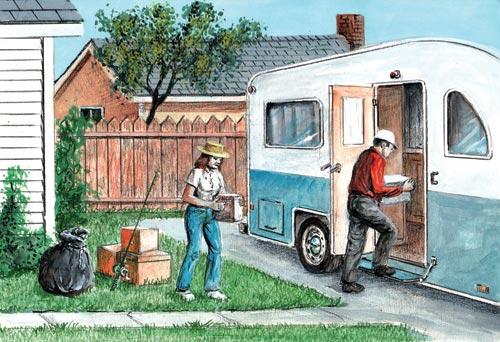
A bug-out vehicle
Obviously, there’s a very real limit to how much each member of a family can carry in their emergency pack. A 20-pound pack may seem like a breeze to carry for a mile or so. But when you have it on your back for hours, it suddenly gets very heavy and tiring to pack.
So we’ve come up with an alternative. We bought an old, cheap 28-foot travel trailer and remodeled it to suit our needs. It cost $500 and had a rotten floor, sagging ceilings from roof leaks, and was in need of a huge cleaning. But it did have a working propane refrigerator and stove.
We fixed the roof leaks first off, then tackled the inside. It didn’t cost much to refurbish; in fact, most of the material came from the dump! Once finished, we started stocking it not just for camping trips but as an emergency bug-out vehicle. I installed shelves next to the door and began filling them with tins and other waterproof and insect/rodent-proof containers in which I store dry foods. I have cornmeal, sugar, bacon-flavored textured vegetable proteins (TVPs), brown sugar, baking powder, rice, dry beans, oatmeal, pasta, and four tins (50#) of flour. Smaller containers hold dehydrated foods like sweet corn, peas, diced carrots, sweet peppers, onion and tomato powder, dehydrated milk, dehydrated cheese blend, dehydrated eggs, and salt.
I keep half a pound of fresh, dry yeast in the freezer of our propane refrigerator. Since it is not running year-round, I rotate it twice a year and put in fresh, as yeast will not stay active at room temperature for much longer than six months. We also try to keep a tin with some cash in the refrigerator. Money may be hard to access in many emergencies. Don’t count on being able to write a check or use a debit/credit card.
The oven is big enough that I can store my old pressure canner inside a water bath canner, with the lid upside down to protect the gauge. And inside that are canning lids and rings. If we have enough warning that we have to evacuate, you can bet we’ll pack several boxes of canned foods into the truck. With the canning equipment I have the ability to replenish our foods, even if I have to can over an open fire.
The shelf above the kitchen sink holds spices, coffee, tea, Tang, a good-quality water filter, tins of strike-anywhere matches, cigarette lighters, and candles. Under the sink I put powdered dish detergent, half a gallon of chlorine bleach (for disinfecting and possible water purification), plastic garbage bags, powdered clothes detergent, and a couple of Coleman lanterns (and extra mantles) well packed against breakage.
Drawers and shelves next to the refrigerator hold our blue enamel tin plates, silverware, spatulas, can opener, and other small kitchen tools, all covered with a mouse/insect-proof metal top.
Instead of the traditional dinette, we added a small pine dresser next to the stove to hold heavy-duty camp cookware and other supplies and a lightweight futon to fold down for a bed, if necessary.
We replaced the furnace, which won’t operate in a longer-term emergency without electricity, with a Mr. Heater Big Buddy™ portable propane heater that is safe for indoor use.
Off the kitchen is a bedroom that contains a “real” double bed mattress on plywood. Under that is storage for bedding in plastic totes so the mice or bugs can’t easily get in and ruin it. The totes can also be emptied and used to wash clothes in or hold water, if necessary. Also under the bed is a rifle and shotgun, plus plenty of ammunition. The cupboards in the bedroom contain clothing, shoes, and boots for the whole family, as well as a weather radio, flashlights with batteries (including a solar-charged flashlight), and some reading material. Above the futon, we store extra clothing appropriate for summer and winter. We also pack a couple of puzzles for those rainy days.
The bathroom contains a linen closet but we’ve added a new garbage can we can fill with dry dog food and a tin of dry cat food. There are towels above that but also an empty space left for our heavy-duty first-aid kit that we keep in the house. It contains medical supplies and medicines from prescription meds (rotated regularly) to suture kits and bandages. Above that is a deep shelf holding a plastic tote full of toilet paper.
We don’t count on using our water system during an emergency. You can’t use a regular water system or toilet in an RV or trailer during the winter in cold climates or the pipes will freeze up and break, ruining the system. Instead, think about using your RV or trailer as a “solid-sided tent.” In cold weather, we line our toilet with garbage bags and toss in a few handfuls of pine shavings on the bottom, then cover solid waste with a handful of shavings at each use. Next to the toilet is a five-gallon bucket with toilet seat, used for urine only. We deposit toilet paper in a paper bag to take outside and burn when needed. When full, the garbage bag in the toilet is topped with shavings and tied shut to store outside until it warms up and it can be disposed of.
For bathing, we use a battery-operated shower, heating the water on our kitchen stove in a canning kettle, then carrying it into the shower/tub. The shower isn’t great but it does get you clean quickly. In the winter, you can melt snow for shower water, if necessary. In the winter, we disconnect our shower/tub drain and hook up a simple PVC pipe to drain the grey water off away from the trailer.
Our under-the-trailer storage holds cans of gasoline, white gas for the Coleman lanterns, extra propane tanks, a chainsaw, bar oil, tools, ropes, and tarps. We keep a 100-pound propane tank full for emergencies, which we could toss into the back of our truck along with more gas cans. We also have a good, dependable portable generator that can easily be loaded in the truck during an emergency evacuation.
On the tongue of our trailer, we carry two full 35-pound propane tanks in their carriers as well as a hydraulic bottle jack, a four-way tire iron, and several wooden blocks. Our spare tire is under the trailer. (We also carry a tire repair kit in our truck and a 12-volt air compressor.)
To keep gasoline fresh, pour cans of gas into your car, truck, or tractor once a month and replace them with fresh. That’s much cheaper than using gas additives. Get in the habit and you’ll always have fresh gas. We keep at least four five-gallon cans of gas on hand at all times.
Keep the gas tank on your truck or other vehicle full at all times. That way, you’ll always have a full tank if you need to evacuate in an emergency. Know the range of your towing vehicle under load, too and be sure you have enough stored gas to get where you plan on going.
Maybe you don’t have or don’t want to have an RV or travel trailer. How about outfitting a van or even a pickup with emergency supplies? It’s sure better than throwing on a backpack and camping out during an emergency — especially in the winter or during bad weather.
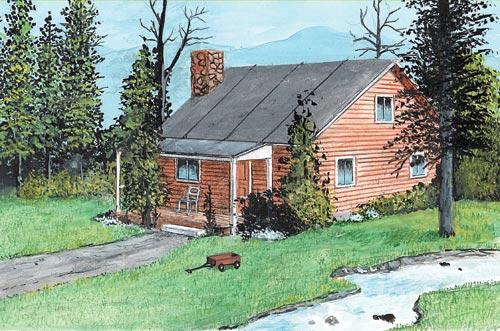
An emergency destination
After the Y2K scare fizzled out, many folks stopped thinking about having a survival retreat — somewhere they could go not only to “survive” but also to regroup after an emergency.
A lot of emergencies, especially serious ones, stick around for awhile. If the power grid becomes damaged, be ready for no gas stations, no banking, no credit or debit card use, no stores open, no heat from your furnace, and no stoplights.
I was raised during the Cold War when, as a child, we expected imminent attack by Russia. There were bomb drills at school. I distinctly remember standing in the dark basement of the school wondering if I would ever see my parents again.
Mom and Dad must have been doing a lot of thinking about that too because Dad bought a several-acre lot way up in the woods in central Michigan. The lot was cheap; there was a great river but no electricity or sewer. We didn’t have much money, but Dad was very handy, so he built his own travel trailer. My parents parked the travel trailer on the lot and proceeded to add on a living-room/kitchen addition and a loft for my two sisters and me to sleep in. We dug out a well, then built an outhouse far from it.
Mom quickly stocked up the “cabin” with dried foods while Dad installed a woodstove in our new addition for heat. During the summer, Dad sawed and split firewood and we carried it under the back of the cabin where there was a raised area under the kitchen to stack and store plenty of dry wood. It was all done on the “cheap” and we could have survived for a long while up there if we had to.
Consider such a retreat for your family. A large lot or small acreage off the beaten track can still be bought cheaply, even in today’s economy. It’s best if it’s away from other folks because you don’t know how desperate people will become if things got truly bad.
A cleared area for a garden is essential. Sooner or later your stored food will run out. And while you’re at it, plan on keeping that garden spot tilled, weed-free, and fertilized with plenty of rotted manure. Even with a lifetime of gardening experience, our first garden here on our wild homestead was a dismal failure. (I would have hated to depend on those tomatoes to feed us … especially after they froze out mid-summer!)
If you do decide to buy a property for a survival retreat as well as yearly use as a family vacation destination, take time to fix it up so it provides good shelter for you and your family, no matter what time of the year it is. Stock it with long-term storage foods that will not be affected by the cold. You don’t have to spend a lot on survival foods bought from survival companies. Your own dehydrated foods from your kitchen will do well. However, I do like to buy some survival foods: dehydrated eggs, butter, cheese blends, and TVPs all come in handy and will store for decades if unopened. Keep all food stored where water, rodents, insects, and light will not affect their quality.
When stocking up your retreat, think constantly about how you might provide such things as alternative heat, power, and water to your family. Projects such as putting down a well, adding an outhouse, stocking up on firewood, or installing a few solar panels, storage batteries, an inverter, and charge controller will all make a huge difference in whether you just “survive” or live comfortably. Plan on getting your emergency water from a nearby lake or river? Better have an ice auger or axe on hand to cut through ice, should it be winter. And if you plan on drinking that water, either filter it or strain it through cloth to remove particles and boil it before using for drinking or cooking.
If you buy bare land, how about building a garage or hunting shack? These minimal buildings don’t require the costly permits that houses or cabins do. But be warned: in some places, once you hook up to a well, you’re required to also provide a septic system for grey water, even if you had planned on using a composting toilet. This is how we ended up with the unplanned expense of a $5,000 septic system. Often you can have a frost-free hydrant outside to get water from your well and still use a composting toilet or outhouse. But once you hook up your well to your house, it’s a whole other ballgame.
Check out your building codes before building or even buying. In some areas you can’t live in a garage while you build a modest home. But codes won’t count if you must move into your garage for temporary housing during an emergency.
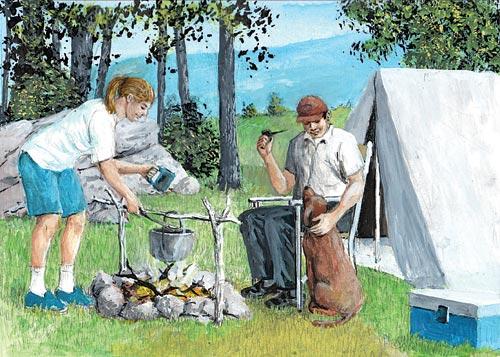
Tent camping
What if you can’t buy a piece of land for a retreat? Do you have a friend or relative that owns land that is relatively remote? Don’t just say to yourself “Well if the SHTF, I’ll just pack up and go to John’s place.” That sure isn’t fair to John!
If this truly is your best option, you’d better have an in-depth talk with John. Would this be okay with him? If so, offer to help out at his place in advance. Help him establish a bigger garden and take care of it. Help him stock up food with your own regular contributions. Go up and help split firewood and generally be of use to him to help develop goodwill. No one, no matter how kind and helpful, wants to haul an unprepared relative or friend out of a hole of their own making. Remember the story of the grasshopper and the ant or the story of the Little Red Hen? There’s truth to those old tales.
Any homesteader is more than happy to have extra hands around the place that are actually helpful. Remember that it does take time to learn any new skills, such as raising livestock, gardening, and putting up food.
If you have no friend or relative that has property for a survival retreat, perhaps the best option would be to find a spot in a State or National Forest where you could set up a secure campsite, in advance. According to regulations, you may not stay in one spot in these places for more than 14 days. But you can find a few relatively close spots and move from one to another, if necessary. Pick out your spots with care. Have them accessible but out of sight from traveled roads and overhead aircraft.
Avoid planning to camp in established campgrounds. They will likely be full of folks fleeing the same emergency situation that you are. And they may not be the nicest of neighbors.
Pick up detailed topographic and Forest Service maps to help you in your search. Check out spots on such websites as Google Earth where you can get a satellite view of different areas. You can do “recon” right from your desk. Try camping at these spots for a weekend. During this time, you can gently clear a spot for parking a vehicle, trailer, or tent by removing dead stumps, branches, and logs. Don’t cut living trees or you may end up in trouble. Try to find spots where running water is readily available but flooding is not probable. Remember you may have to get to your spot in the winter so choose both summer and winter spots. A four-wheel-drive truck or ATV will make your year-round choices easier. But some spots, such as our old homestead in Montana, are only accessible in the winter by snowmobile or snowshoes/skis. We had more than six feet of snow on the ground from December until May.
Think about food procurement. Fishing is the best option, so pick your location where there are nearby rivers or small, unpopulated lakes. Don’t count on hunting deer to survive. That’ll probably work for a while. But when populations take to the woods to use hunting as their primary food source, the deer population quickly declines. That’s what happened during the homesteading days back in the 19th century.
Tent camping in an emergency situation is rugged at best and, depending on the time of year, can be brutal. While there are a lot of good-quality tents available today, absolutely nothing beats a canvas wall tent. They are built to withstand wind, rain, and snow loads, big enough that you can stand and walk in them, and framed to accept a stovepipe for a small woodstove. They are not cheap, but they will keep you warm and dry in a semi-permanent remote campsite.
We have a wall tent that we got at the dump, believe it or not. It had one small hole, which I sewed up and waxed to prevent leaking. We used it, years back, for temporary housing when we moved up in the mountains in Montana. With a canvas tarp floor it was quite comfortable. This tent and tarp floor are now folded and stored in our travel trailer.
In most State and National Forests, you can cut any dead or downed firewood to use for cooking or heat. Having a small chainsaw and axe is a great help in keeping warm. We had a small, flat-topped woodstove for our tent that I could cook on as well as use for heating.
Having a couple of smaller tarps folded and ready, along with some lightweight nylon rope, such as paracord, makes it easy to fashion firewood protection or a rain fly in front of the tent. When it rains for days you’ll get real sick of sitting in the tent. Even moving around outside under a rain fly helps. Avoid those bright blue plastic tarps. You don’t want to stick out like a sore thumb in the woods. A better choice is black or brown if you must use a plastic tarp. Or go with a well-worn tan canvas tarp.
Besides a sturdy tent, you’re still going to need a winter-quality sleeping bag for each member of the family, cooking gear, food, water containers, a first aid kit, and weather-appropriate clothing … not to mention soap, toilet paper, and a shovel, all packed beforehand.
No matter what, tent camping can only be looked on as “temporary” housing. You have no way to store long-term foods and when you’re used to modern living, even a large wall tent will soon become cramped and uncomfortable for you and your family. When an emergency situation lingers on, you’ll soon wish that you would have picked up a small, isolated piece of property.
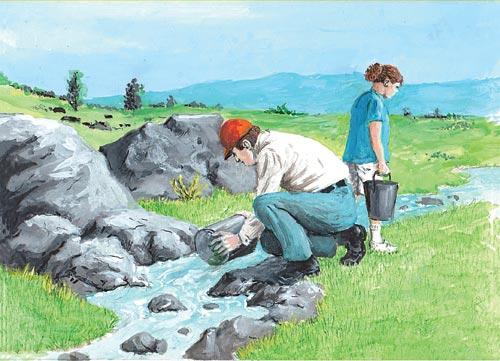
Getting to your survival spot or retreat
Everyone seems to think they’ll just throw their stuff into the car and head out to the “boonies” where it’s safe. If you wait until things really get bad, the roads will quickly become clogged with others fleeing the scene. Remember the televised pictures and videos of plugged highways when people evacuated just before Katrina? Multiply that by 10 if a major terrorist event happened or some national crisis necessitated urban evacuation.
Stay aware. When I grew up in Detroit, I quickly learned that in order to walk the sidewalks in relative safety, I needed to be aware of what was going on around me. Likewise, pay attention to what’s going on in the world, the country, your state, and your city. Don’t wait until everyone else decides it’s time to flee or the Feds declare a forced evacuation. When in doubt, leave … before the roads become clogged, before the troops are called in, before leaving becomes impossible.
Don’t leave through cities or on major highways (unless they are very clear). Avoid toll roads and other bottlenecks that could become closed or clogged. Get a map and pick alternate routes to your destination and travel them before you need to. You don’t want to be in an emergency situation and find that the bridge over the big river on your escape route is closed for repairs.
Know what the range is for your vehicle’s gas tank. Some pickup trucks have dual tanks. Keep ’em both full, then switch from one to the other, refilling the empty tank so you always have two full tanks of fresh gas. Like we do with our travel trailer, keep a few full five-gallon gas cans stored safely in your truck box or the trunk of your car. With a full tank and a few cans of gas, you should be able to get nearly anywhere safely without having to worry about stopping for gas.
Be sure to have a plan that you share with members of your family. Luckily, with most people having cell phones, keeping in contact is much easier these days, even in an emergency situation. But there are some scenarios that could knock out cell phone towers and reception, so plan that you will all meet at a designated spot if an emergency arises.
What about the critters?
Here, our chances of having to evacuate our land are very small. Our pastures are clear of trees and the grass is either green or short, depending on the season — no long, dead grass to catch fire or trees to support wildfire.
And we now have too much livestock to take with us. Most would have to be left behind, except for our “pet” horse and cow and the goats. All will load up in our stock trailer quickly, with no fuss, with a bucket of grain. We can load six bales of hay on the sides of our stock trailer and put more in the truck, if necessary (if it’s winter).
We feel quite certain that the livestock left home would be pretty safe; not many terrorists bomb the woods of northern Minnesota and our livestock can escape fire in the pastures.
Our dogs have been riding in the truck for a long while and are now good travelers. If your pets are not used to riding in the car, it’d be a good idea to slowly get them used to it now.
If your dogs can’t be depended on to obey and stick close to you, pack leashes and tie chains so you can keep them from roaming until they get settled in their new temporary home. Don’t let your cat run free outside until you are very sure he won’t panic and run away. Cats are quite nervous and often become disoriented in unfamiliar settings. Be careful.
If you will be crossing state lines to reach your destination, be sure to have your pets’ vaccinations current, especially their rabies vaccinations, and keep their papers handy. You probably wouldn’t be stopped at a time of emergency but you never know.
Having a dog or dogs around is not only company but also a deterrent to would-be thieves. A good protective family dog that has sense and will obey is invaluable. I’m not talking about an attack or guard dog; these are way too dangerous. But a good, dependable dog like our Spencer (big black Labrador) is gold. He would never bite children or neighbors, but when he feels we are threatened, his hair stands up and his bark is not pleasant.
Personal essentials
We have all of our important papers in a small file box: birth certificates, vehicle titles, deeds to the property, passports, marriage and death certificates, and the dogs’ and cat’s vaccination records. This box is small and easy to carry. Consider doing this so in an instant, you can grab one box and go. Our metal box fits under the seat of the truck handily.
You also might include your laptop if power is still an option. Don’t forget 12-volt chargers for your laptop and cell phone.
Practice your plan of action
It helps to jot down a few notes as you go, detailing when you might leave, what you’ll take, and where you plan on going. Then give it a dry run, mentally and physically, at least a few times. The more you do something, the more automatic it will become. If you discover holes in your plan, fill them before it’s critical.
With planning, you can cut down a whole lot of stress involved with different emergency situations, knowing just what you’ll do, if you’ll leave, where you’ll go, and how your family will not only survive but do well comfortably until you can return home. We don’t live with fear but with confidence in our ability to handle the future.


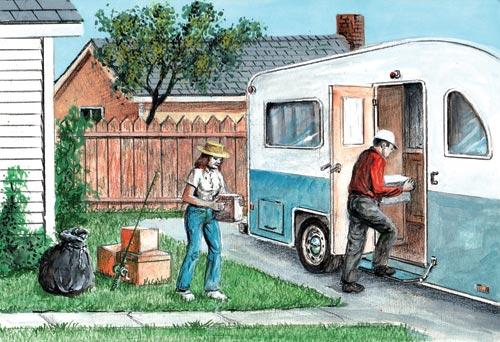








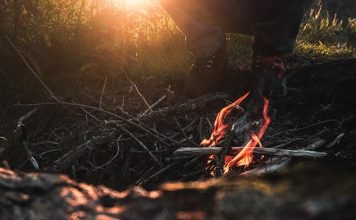

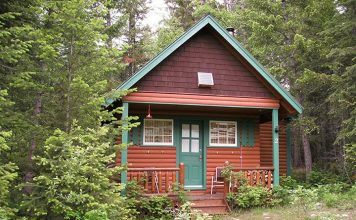



Very good article. We also, have a 20′ travel trailer and a stout 4×4 pickup. Our preps are similar to yours, and your suggestions make real good sense to us.
Thanks so much for your insights and advice!
Good article Jackie.